#wildlife rescue
Text
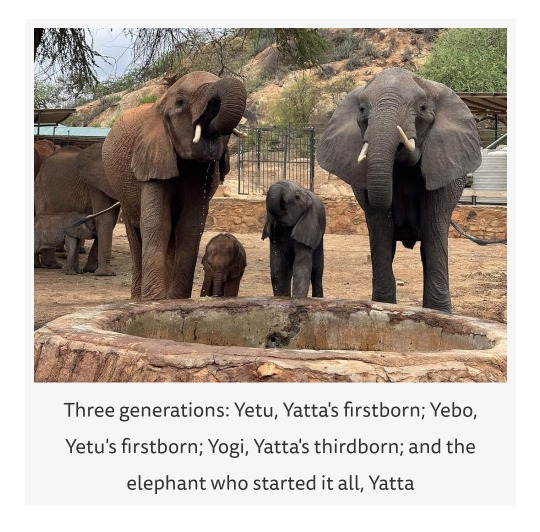
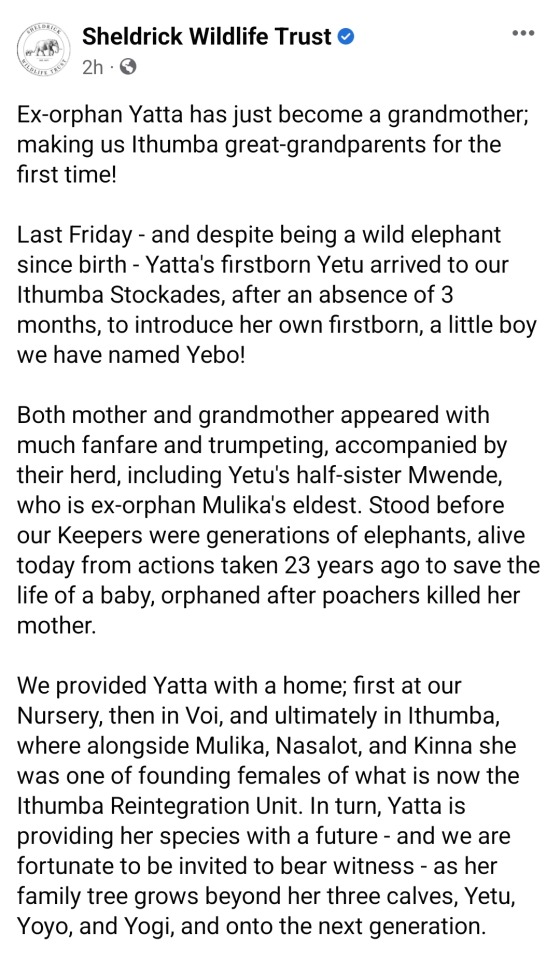
This is just SO cool and so cute!!! Sheldrick Wildlife Trust, a wildlife & conservation organization, is celebrating their first "great-grand-baby" elephant! One of their many programs is raising orphan wildlife, primarily elephants. Their program has been going for over 5 decades! They discovered the right formula to sustain milk-dependent baby elephants, and I believe rhinos as well.
This year they've reached 52 calves born to ex-orphans in the wild, which is absolutely amazing. But now they have their first one born to one of THOSE calves, making ex-orphan Yatta a grandmother!
Here's the longer blog post with the stories for this amazing elephant family. This bit at the end made me cry -

@hope-for-the-planet this seems like your kind of post!!
#wildlife#wildlife conservation#elephants#wildlife rescue#conservation#i love following this organization#they have so many cool programs#including education and community support#which are so so integral to conservation efforts#this is just so cool for them
3K notes
·
View notes
Text
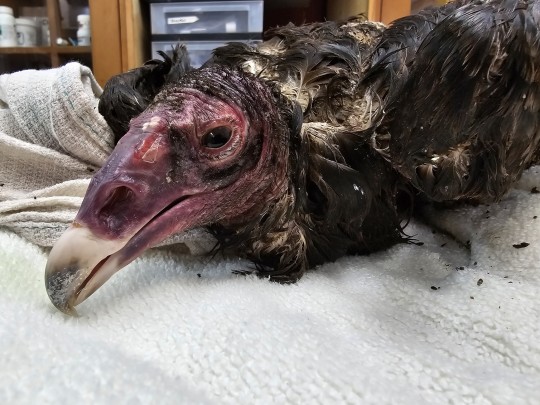
Thanks to workers at the Blimp Road water treatment plant for making the rescue of a Turkey Vulture down in a processing tank. We are treating the Vulture in our clinic now.
311 notes
·
View notes
Photo

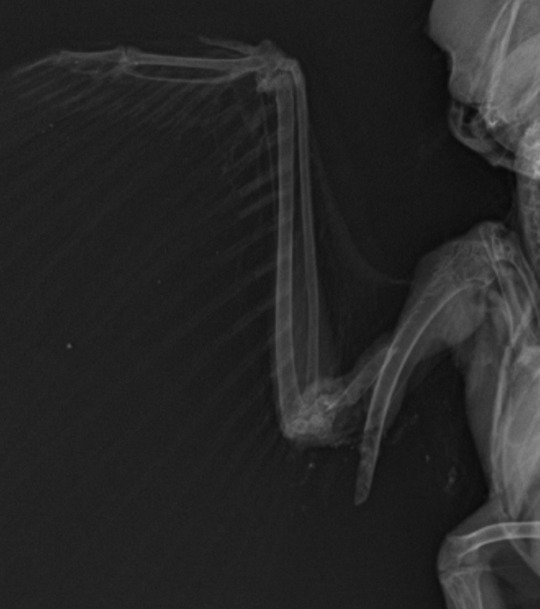
This is why you don’t keep wildlife, folks. This baby Eastern Screech-Owl was rescued from Floyd after being found and kept by someone for weeks and was encouraged by others online to keep this bird rather than take it to a rehabber. Sadly, this little owlet had a badly fractured wing — this injury could have been surgically fixable if the bird had been brought to us when it was found. However, because the bird had been kept from medical attention for so long, the bone was dead and there was no longer a way to fix this very painful wing injury.
People, we know wild animals are cute, cool, and getting the chance to be with one up close is an amazing and unforgettable experience. We know it is tempting to keep them and take it on yourself. We all think we are capable and that we know what’s best — it is just human nature. But the reason why we ask people to bring wildlife to us is not out of greed or because we feel we know more than you, but because every week we see what happens when people try to take matters in to their own hands. Imagine what it is like to receive animals that you know you could have saved if people had brought the animal to you when it was healthy. It’s hard to keep a straight face some days.
Call us. We’re here to help you. Don’t let your ego get in the way of what is right for the animal. Without our existence, we know thousands more would needlessly suffer because of people DYI-ing rehab at home.
Be a hero. Make the call even if you don’t want to. A life may depend on it.
#eastern screech owl#owl#owlet#bird#birds#wildlife#wildlife rehab#wildlife rescue#raptors#animal death for ts#x ray
3K notes
·
View notes
Text
Little old man
Credit: theorangutanproject on instagram
311 notes
·
View notes
Text
Okay, this is…way outside of my usual.
First of all, animal tax for taking your time (more photos further down I can’t format worth anything lol)
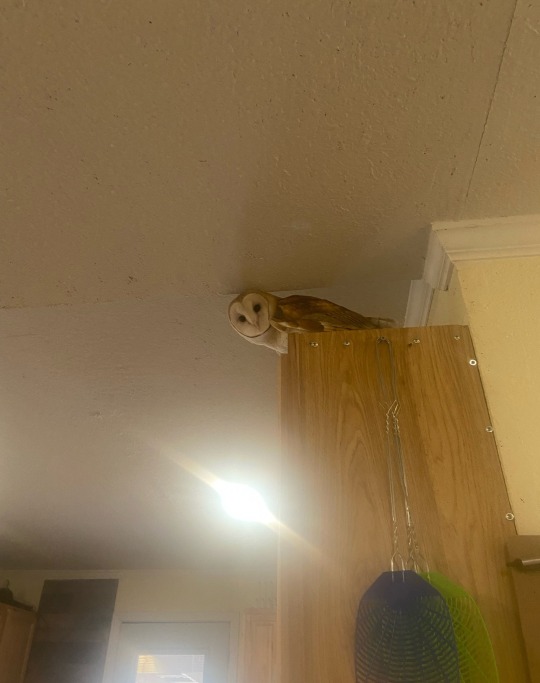
I volunteer with a local wildlife rehabilitation center. The only state, federal, and USDA licensed one in the upper 26 counties of the Texas Panhandle, although we have cared for animals from all over the state. We’ve had everything from half-tamed bengal cats come in from a hoarder’s house to a million and one orphaned starlings in our doors.
There’s always a lot of animals, no matter what, because unfortunately the education towards wildlife in this area is exceedingly poor and most people are either afraid of most animals or see them as nothing more than pests. We’ve had a fair number of animals shot, poisoned, trapped, the parents killed and then the land/homeowner finds the nest of babies…the list goes on.
To combat this, we have always pushed education. We have programs all across the area, we go to schools and churches and scout groups. We’re currently working on building an education building, both to give our educational ambassadors larger and nicer habitats to live in and to have a place to hold events for the community. As the founder of the center always says, “You can’t love what you don’t know”.
This building is by no means cheap. We’re getting close to having it fully funded, but we’re short by several thousand dollars.
Currently, we are having our biggest donation drive of the year, and our goal is to try to have most of the education building paid off from this. We’re also having a bit of a friendly competition among the volunteers to see who can get the most donations.
The best part of this is no matter how small the donation may be, we have donors who are going to amplify the donations. So even if you only give a small amount, it will be worth a lot more!

To donate, go here.
Thank you in advance to everyone who gives or reblogs to spread this!
The promised animal tax:
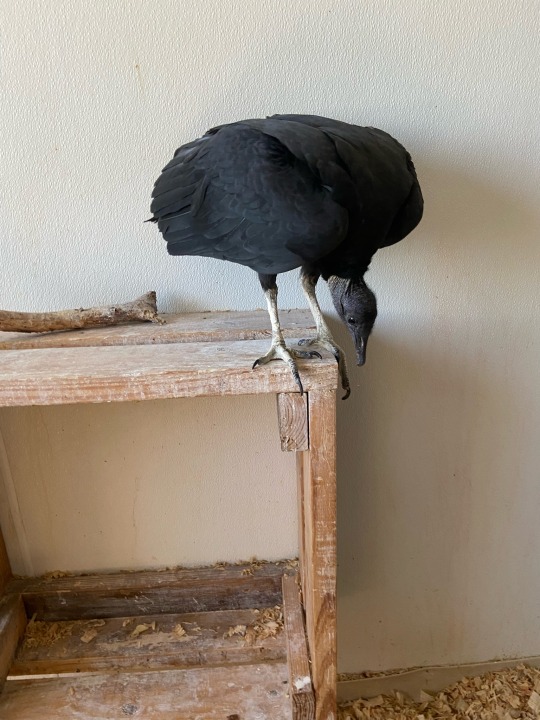
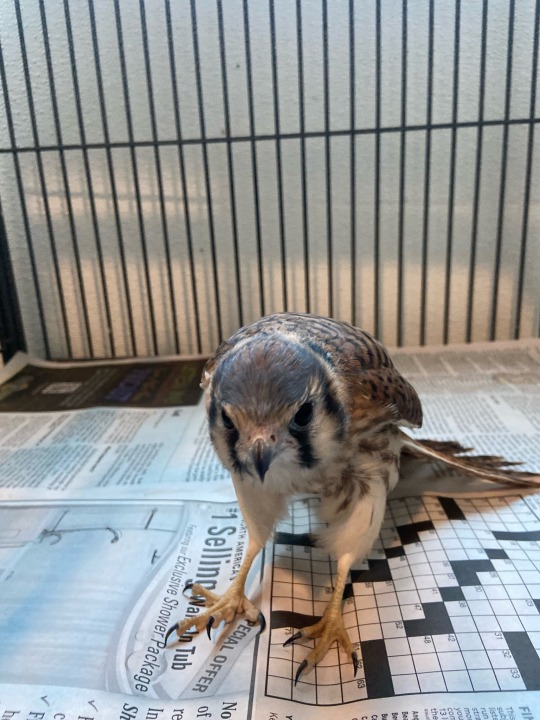
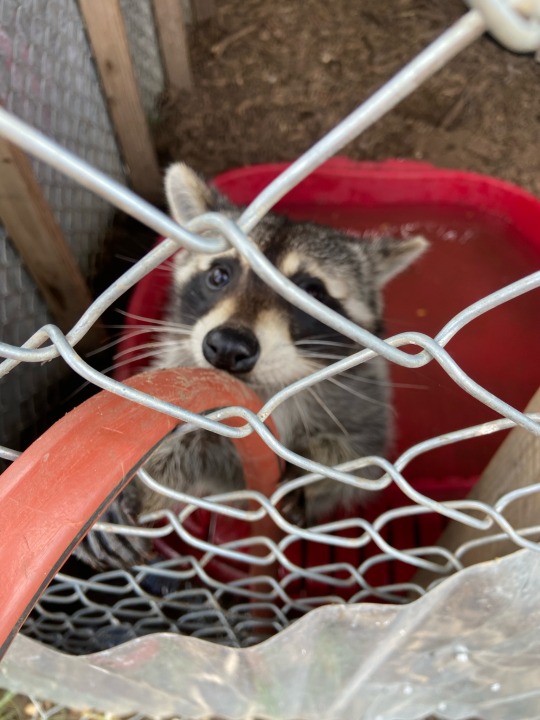

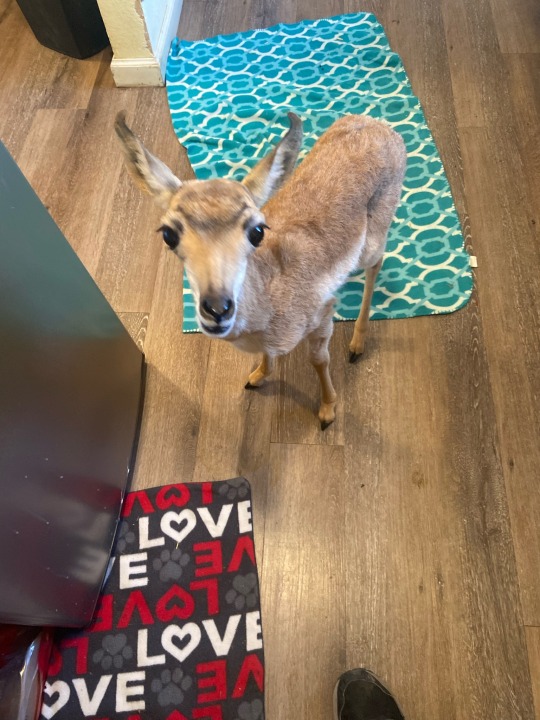
#cute animals#wildlife rehab#wildlife#wild animals#wildlife rescue#animals#raccoon#owl#pronghorn#vultures#vulture#black vulture#barn owl#fox#grey fox#gray fox
78 notes
·
View notes
Text
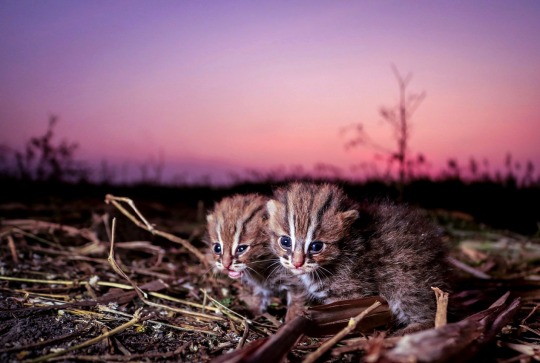

Rusty Spotted Cat Kittens
Wildlife SOS on Smugmug
145 notes
·
View notes
Text


Best rescue of the week so far; this nakey lil joey that I arranged a vet to assess after she was orphaned <3
#tbh they're mildly cursed when they're in the velvet stage of development but i mean look at her face ain't she just the sweetest!!#and she got a lot of interest too - i think she was at the vet for like 5 minutes before a bunch of carers reached out to take her in pfft#so she's in good hands now what a relief <3#my stuff#work shenanigans#kangaroos#wildlife rescue
29 notes
·
View notes
Text

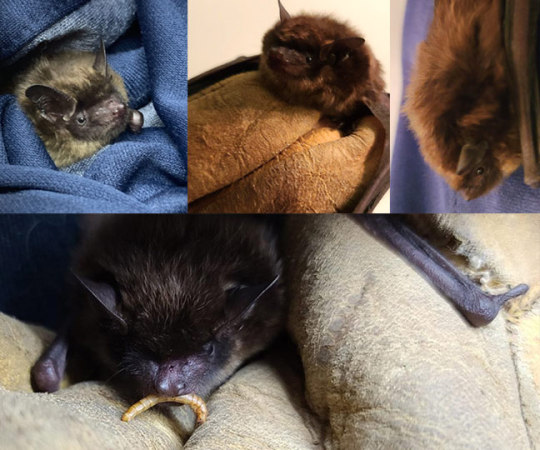

Calling all bat lovers! Next up to unlock on our Kickstarter fundraiser is the bat pendant! Stickers, prints, and the original watercolor painting are also available: Learn more at: tinyurl.com/me9r66ac
A lot like vultures, bats are ecosystem superheroes who need good PR and more positive representation in art and media, so I was really happy to work on this design. We are experimenting with some transparent glass-like enamel effects for the wings of these pendants, and I think they will turn out really eye-catching and unique!
When I first started in wildlife rehabilitation, I ended up working with a lot of bats, which really increased grew my fondness for them. Even though I specialize in birds and don't usually take mammals, I can't turn away a bat in need (the photos are of some of our brown bat rehab patients).
Thanks for taking the time to look. Shares greatly appreciated if you know anyone you think might enjoy!
38 notes
·
View notes
Photo

IMPORTANT!!!
“This is probably one of the most important posts we will do. Please spread the word! Every year rehabbers receive orphans that they are unable to save simply because the finder fed the animal while they had it. Seems crazy right? How could feeding an animal hurt it? This is how: Many orphans are found with hypothermia (low body temperature) and extreme dehydration. When an animal is in this state, it CAN NOT digest anything. Its body simply can not process food. If offered food in this state, the animal will most likely die. Also, there are very specific formulas that wildlife rehabbers use for each particular species of animal. Offering the orphan the wrong kind of formula can cause extreme discomfort, diarrhea and even death. If you have found a baby that you know to be orphaned, please place it in a warm, dark and quiet place and contact your local wildlife rehabilitator for further instruction and assistance.
Thank you so much for caring about our local wildlife.”
Via Newhouse Wildlife Rescue
534 notes
·
View notes
Text
Ukrainian soldier nurses wild bird back to health on the front lines.
19 notes
·
View notes
Text
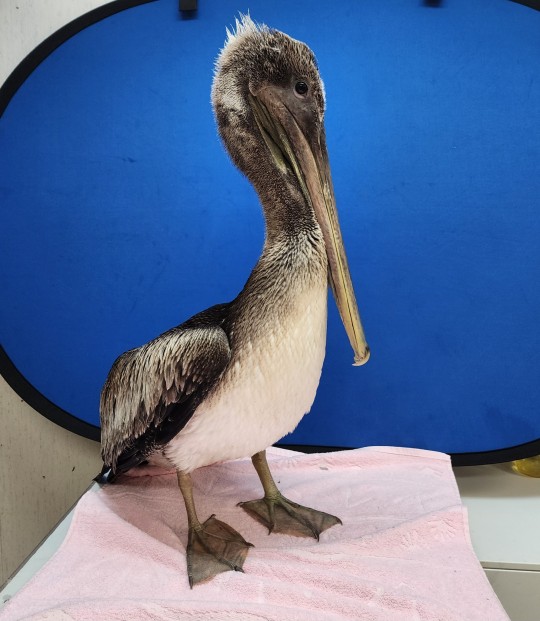
Thanks to Fishmonster for making the call about this extremely weak, underweight and dehydrated first-year Brown Pelican! We just made the rescue behind Conch Republic. The Pelican has been administered fluids, warmed up, and treated for parasites to begin rehabilitation in our clinic. Thanks to all involved in this rescue.
165 notes
·
View notes
Photo


Ever seen a sleeping hawk? This Red-shouldered Hawk looks rather goofy without his head but tucking your head between your shoulders is actually a common sleeping position for most birds. In fact, preserved dinosaurs have been discovered in similar sleeping positions to modern birds. Birds don’t always tuck their head behind their shoulders but there seems to be advantages (and disadvantages) for doing so. One study found that migrating warblers who are low on fat stores sleep in this position to conserve energy in a deeper sleep while warblers with ample fat supplies sleep with their heads exposed, facing forward! Those that slept with their heads tucked reacted slower to noises of potential predators while those who slept more on alert could quickly react to any potential danger. Some other reasons for head tucking can be body temperature regulation (keeping warm) and feeling safe and secure.
192 notes
·
View notes
Text



in case anyone needs a pick-me-up today, here's a bundled up roe deer on its way to rehab. their legs have to be tied up to prevent injuries during transportation, resulting in the cutest little package 💖
#mine#things i do#<3#deer#wildlife rescue#(we actually ended up catching and transporting 3 of them today)#winter means rapeseed intoxication for wildlife :(
11 notes
·
View notes
Text
In happier beluga related news, Tyonek the beluga recently celebrated 5 years at SeaWorld San Antonio! In 2017, Tyonek was found stranded as a neonatal calf, in such poor condition that the individuals who found him initially believed he was dead. He was nursed back to health by the dedicated team at the Alaska SeaLife Center (as well as experts from other aquariums who flew in to assist!) and, after being declared non-releasable by NOAA due to his incredibly young age at stranding, moved 4,000 miles south to SeaWorld San Antonio to join their pod of belugas and Pacific white-sided dolphins, which includes several experienced mothers and other youngsters to grow up with.
Tyonek is a member of the endangered Cook Islet population of beluga whales and serves as a wonderful ambassador for his wild family, as well as providing valuable insights to researchers. He is the first beluga ever to be successfully rescued and rehabilitated!

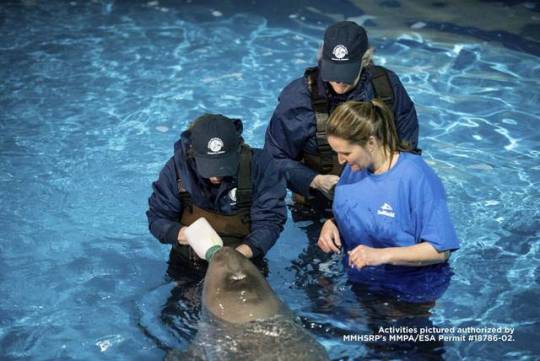
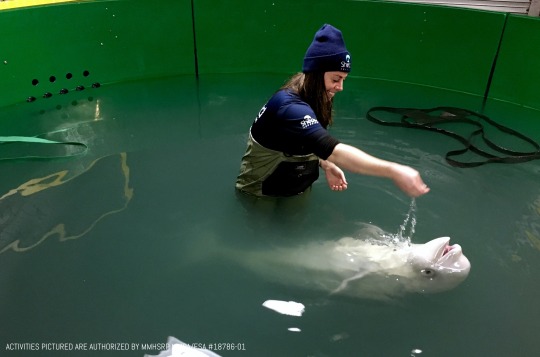

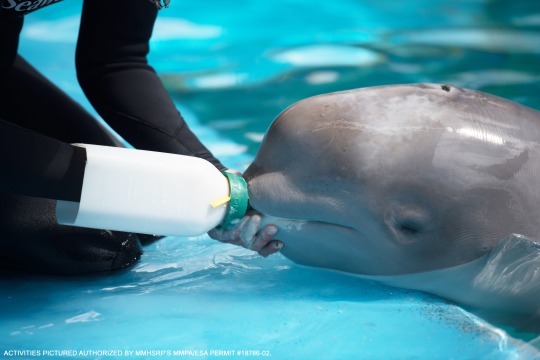
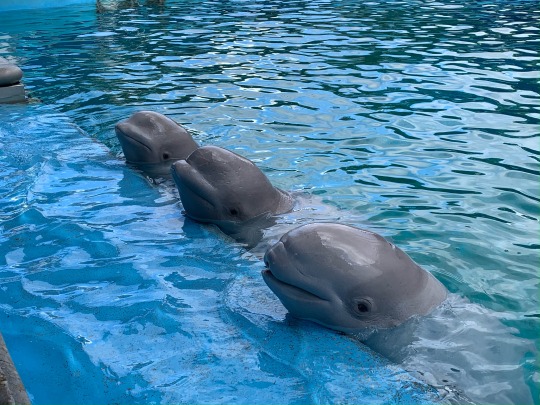
#belugas#cook islet belugas#cetaceans#marine mammals#seaworld#alaska sealife center#wildlife rescue#wildlife rehab
29 notes
·
View notes
Text
@sheldricktrust 🐘
"Mwana gets a goodnight kiss from Sora, one of the Keepers who raised her mother. This sweet moment comes with a hearty dose of Mwana sass — it looks like she’s promising that their game will continue tomorrow. Sure enough, first thing the next morning, she made a beeline for Sora to recommence their playful dance!
Mwana stands out as our most unique ‘grandchild.’ Her mother, Murera, is an orphaned elephant we rescued, raised, and re-wilded. However, she came to us with grievous, human-inflicted injuries that will affect her for the rest of her life. For this reason, Murera prefers to remain close to home, even after giving birth to Mwana, leaning on her Keepers for the support and security that help her thrive.
Thus, Mwana is an elephant of two worlds. She was conceived with a wild bull and has an entirely wild future ahead of her, but she also enjoys a wonderful connection with her human-orphan family at Umani. She has a particularly special bond with Sora: While Murera took to motherhood right away, she initially wouldn’t allow Mwana to nurse. (We aren’t exactly sure why.) For 11 days and 11 nights, Sora and another Keeper named Evans milked Murera, then bottle-fed Mwana, sustaining the newborn until Murera’s nursing instincts kicked in. While Murera now feeds her baby herself, Mwana still feels very connected to her Keepers."
If you would like to learn more about Mwana and Murera’s remarkable story, visit:
sheldrickwildlifetrust.org/news/fieldnotes/april-2023
* This video was taken six months ago — Mwana has grown quite a bit since then!
36 notes
·
View notes
Text
I've been seeing way too many "heartwarming" videos of people rescuing injured wild animals and taking care of them, but I need people to understand that you should NOT do that. I don't mean just leave the animal there, but you shouldn't bring it in to your home thinking you can rehabilitate it by yourself or keep it as a pet.
Instead, you should take the animal to the nearest wildlife rehabilitation center. Those centers have vets and staff who are experienced in treating wildlife and who have the correct materials to heal the animal and let them back into the wild. The average person just does not have the materials or knowledge to keep the animal alive or heal it. I get that you will want to do the right thing, and you may think you are prepared, and it feels good to personally help an animal, but in truth the right thing to do is give them to a proffessional who has a better chance of keeping that animal alive than you do.
There is also the fact that animals can carry diseases which can pass to humans and other animals. Bringing a wild animal into your home (and especially one which is injured and could be ill) is a risk to you, your family, and any existing pets. If you are going to take an animal to a rehabilitation center, you might want to call them first and ask how to protect yourself while retrieving the animal (or they might send someone to your location to do it for you). If you cannot contact them right away, make sure you are completely covered, including gloves. Also be sure you know how to correctly handle the animal in question (bunnies, if handled incorrectly, can break their bones while trying to kick you away). There is still a chance you will get bitten or scratched, which puts you at risk for serious diseases like rabies and rat bite fever.
NEVER rescue an animal from a predator. This puts you at risk of injury and also deprives the predator of much-needed food. It can be really sad to see an animal eat another, but that is how nature works and they all need to eat somehow. Taking a squirrel away from a hawk, for example, means the hawk now does not have food to feed itself or potential offspring, and it can starve. Let nature take its course.
It is different for stray cats and dogs, in which case you should call animal control, which will bring the stray to a shelter where they can be healed, neutered/spayed (to prevent more strays) and then either released back where it came from or put into adoptions. Some shelters will contact you if the stray is put into adoptions so you can get a choice hold.
#psa#animals#animal shelter#wildlife#wildlife rehab#wildlife rescue#animal video#veterinary#veterinary medicine#vet med#vet#cute animal#cute animals#pets#petblr#vetblr
47 notes
·
View notes